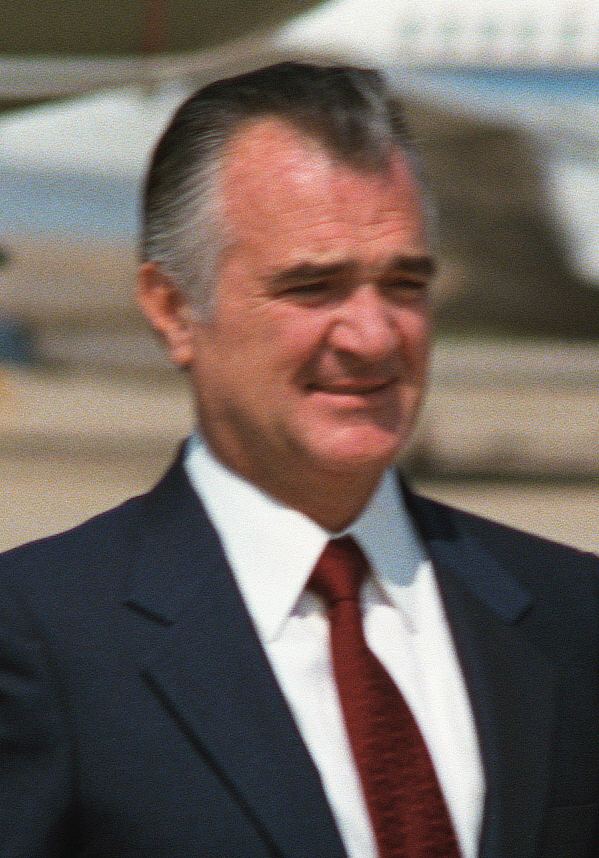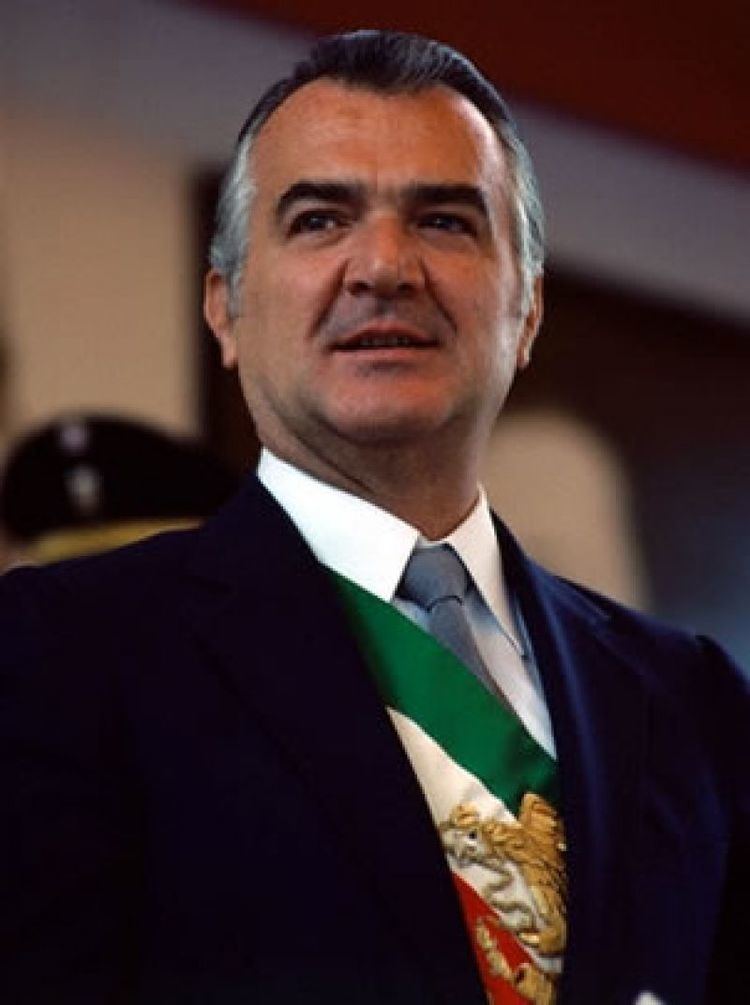Preceded by Jose Lopez Portillo Name Miguel la Nationality Mexican | ||
 | ||
Full Name Miguel de la Madrid Hurtado Born December 12, 1934Colima, Mexico ( 1934-12-12 ) Died April 1, 2012, Mexico City, Mexico Presidential term December 1, 1982 – November 30, 1988 Spouse Paloma Cordero Tapia (m. 1957) Children Enrique de la Madrid Cordero Books Third State of the Nation Report, 1985: To the Mexican Congress by Miguel de la Madrid H., President of Mexico Similar People Carlos Salinas de Gortari, Jose Lopez Portillo y Pacheco, Ernesto Zedillo, Luis Echeverria, Enrique de la Madrid Cordero | ||
Resting place Iglesia de Santo Tomas | ||
El gobierno de miguel de la madrid
Miguel de la Madrid Hurtado ([miˈɣel delamaˈðɾið uɾˈtaðo]; December 12, 1934 – April 1, 2012) was a Mexican politician affiliated with the Institutional Revolutionary Party (PRI) who served as the 52nd President of Mexico from 1982 to 1988. His presidency was notorious for introducing sweeping neoliberal economic policies in Mexico (beginning an era of neoliberal presidents in Mexico) and for his administration's slow response to the 1985 Mexico City earthquake that occurred halfway throughout his administration.
Contents
- El gobierno de miguel de la madrid
- Living History presents Miguel de la Madrid
- Early life and education
- Early career
- Domestic policy
- Foreign policy
- Director of FCE
- Personal life and death
- References

Living History presents Miguel de la Madrid
Early life and education

Miguel de la Madrid was born in the city of Colima, Colima, Mexico. He was the son of the late Miguel de la Madrid Castro a notable lawyer (who was assassinated when his son was only two) and Alicia Hurtado Oldenbourg. His grandfather was Enrique Octavio de la Madrid, the governor of Colima.
He graduated with a bachelor's degree in law from the National Autonomous University of Mexico (UNAM) and received a master's degree in Public Administration from the John F. Kennedy School of Government at Harvard University, in the United States.
Early career
He worked for the Bank of Mexico and lectured in law at UNAM before he got a position at the Secretariat of Finance in 1965. Between 1970 and 1972, he was employed by Petróleos Mexicanos, Mexico's state-owned petroleum company, after which he held several other bureaucratic posts in the government of Luis Echeverría. In 1976, he was chosen to serve in José López Portillo's cabinet as secretary of budget and planning.
He was president after López Portillo. He won the elections that took place on July 4, 1982, and took office the following December.
He was a member of Collegium International, an organization of leaders with political, scientific, and ethical expertise whose goal is to provide new approaches in overcoming the obstacles in the way of a peaceful, socially just and economically sustainable world.
Domestic policy
Unlike previous Mexican leaders, he was a market-oriented president. Inflation increased on an average of 100% a year and reached to an unprecedented level of 159% in 1987. The underemployment rate soared to 25% during the mid-1980s, income declined, and economic growth was erratic since prices rose usually much faster than incomes.
All that was a stark reminder of the gross mismanagement and inept policies of his two immediate predecessors, particularly the financing of development with excessive overseas borrowing, which was often countered by high internal capital flights.
During his presidency, he introduced neoliberal economic reforms that encouraged foreign investment, widespread privatisation of outdated state-run industries, and reduction of tariffs, a process that continued under his successors, and which immediately caught the attention of the International Monetary Fund (IMF) and other international observers. In January 1986, Mexico entered the General Agreement on Tariffs and Trade (GATT) following its efforts at reforming and decentralising its economy. The number of state-owned industries went down from approximately 1,155 in 1982 to 412 in 1988.
As an immediate reaction to the economic crisis, he first presented the Immediate Economic Reorganization Program (Programa Inmediato de Reordenación Económica) and, a couple of months later, the National Development Plan (Plan Nacional de Desarrollo). Some of the measures proposed were a reduction of public spending, fiscal reforms, a restructuring of the bureaucracy, and employment protection.
His administration's mishandling of the infamous 1985 Mexico City earthquake damaged his popularity because of his initial refusal of international aid. It placed Mexico's delicate path to economic recovery in an even more precarious situation, as the destruction extended to other parts of the country.
During his administration, an electoral reform was conducted in 1986:
Cuauhtémoc Cárdenas and other politicians from the Institutional Revolutionary Party (PRI) announced the creation of the Democratic Current (Corriente Democrática) within the PRI. The Democratic Current demanded the establishment of clear rules for the selection of the party's presidential candidate. When they failed, Cárdenas and Porfirio Muñoz Ledo left the PRI and joined the National Democratic Front (Frente Democrático Nacional), a loose alliance of left-wing parties.
Galloping inflation, the controversial privatisation programme and austerity measures imposed by his administration caused the ruling party to lose ground, leading up to the controversial elections of 1988. On Election Day 1988, the computer system used to count the votes shut down, as Cárdenas held an initial lead. That event is remembered by the prase se cayó el sistema (the system crashed). When the system was restored, Carlos Salinas was declared the winner. The expression “se cayó el sistema” became a euphemism for electoral fraud.
Foreign policy
In 1983, the Contadora Group was launched by Colombia, Panama, Venezuela and Mexico to promote peace in Latin America and to deal with the armed conflicts in El Salvador, Nicaragua, and Guatemala.
Director of FCE
After completing his term, he became the director of the Fondo de Cultura Económica (FCE) in 1990. He implanted modernizatin programs in production and administration. It incorporated the most advanced techniques in book publishing and graphic arts and maintained the openness and plurality features in the publication policy of the company.
On September 4, 1992, he inaugurated the new facilities, on 227 Picacho-Ajusco Road. Surrounded by garden and offices, it hosts cultural unity Jesús Silva Herzog, the Gonzalo Robles Library, which houses the growing publishing history of the Fund, and the seller Alfonso Reyes.
On the international scene in 1990, the existing facilities were remodeled subsidiaries. The presence of the Economic Culture Fund acquired a larger projection in the Americas: on September 7, 1990, the subsidiary in San Diego, California, was founded. On June 21, 1991 Seller Azteca opened its doors in São Paulo, Brazil. In 1994 FCE facilities were inaugurated in Venezuela, and in 1998, another subsidiary was established in Guatemala. This Thus, the FCE reached a significant presence in Latin America with nine subsidiaries: Argentina, Brazil, Colombia, Chile, Spain, United States, Guatemala, Peru and Venezuela.
In publishing field, under his direction, 21 new collections were launched: in 1990, Keys (Argentina) in 1991, A la Orilla del Viento, Mexican Codices, University Science and Special Editions of At the Edge of the wind; in 1992, Breviary of Contemporary Science (Argentina) and New Economic Culture, in 1993 Library Prospective, Mexican Library, Library Cervantes Prize (Spain), and History of the Americas Trust and Cruises, in 1994, Word of Life and Indians A Vision of America and the Modernization of Mexico; Files, Sunstone (Peru), Entre Voces, Reading and Designated Fund 2000; Encounters (Peru) History of Mexico, and five periodicals: Galeras Fund, Periolibros, Images, Spaces for Reading and the Fund page.
During his administration, the FCE received several awards, among them: in 1992, FILIJ Book Award (CNCA) to children's books, in 1993 Golden Laurel Award (Department of Culture of the City of Madrid) in 1993, honorable mention Juan García Bacca (Peruvian Cultural Association) Award, and Gold Aztec Calendar (Mexican Association of Radio and Television). In 1994 and 1995 Award Book Bank of Venezuela for children's books.
The Spanish Council for Latin American Studies, distinguished him for his contributions to the development of reading in the Spanish language, received in 1997 the IUS Award by the Faculty of Law of the UNAM, and in 1998 the government of France awarded him the Academic Palms in rank of Commander for his contribution to cultural development. In 1999, Mr. De la Madrid received the medal Picasso Gold (UNESCO), for their work on the diffusion of Latin American culture.
Personal life and death
De la Madrid died on April 1, 2012, at 7:30 am in a Mexican hospital apparently following a lengthy hospitalization for complicated chronic obstructive pulmonary disease, which led to acute renal failure and cardiac arrest.
